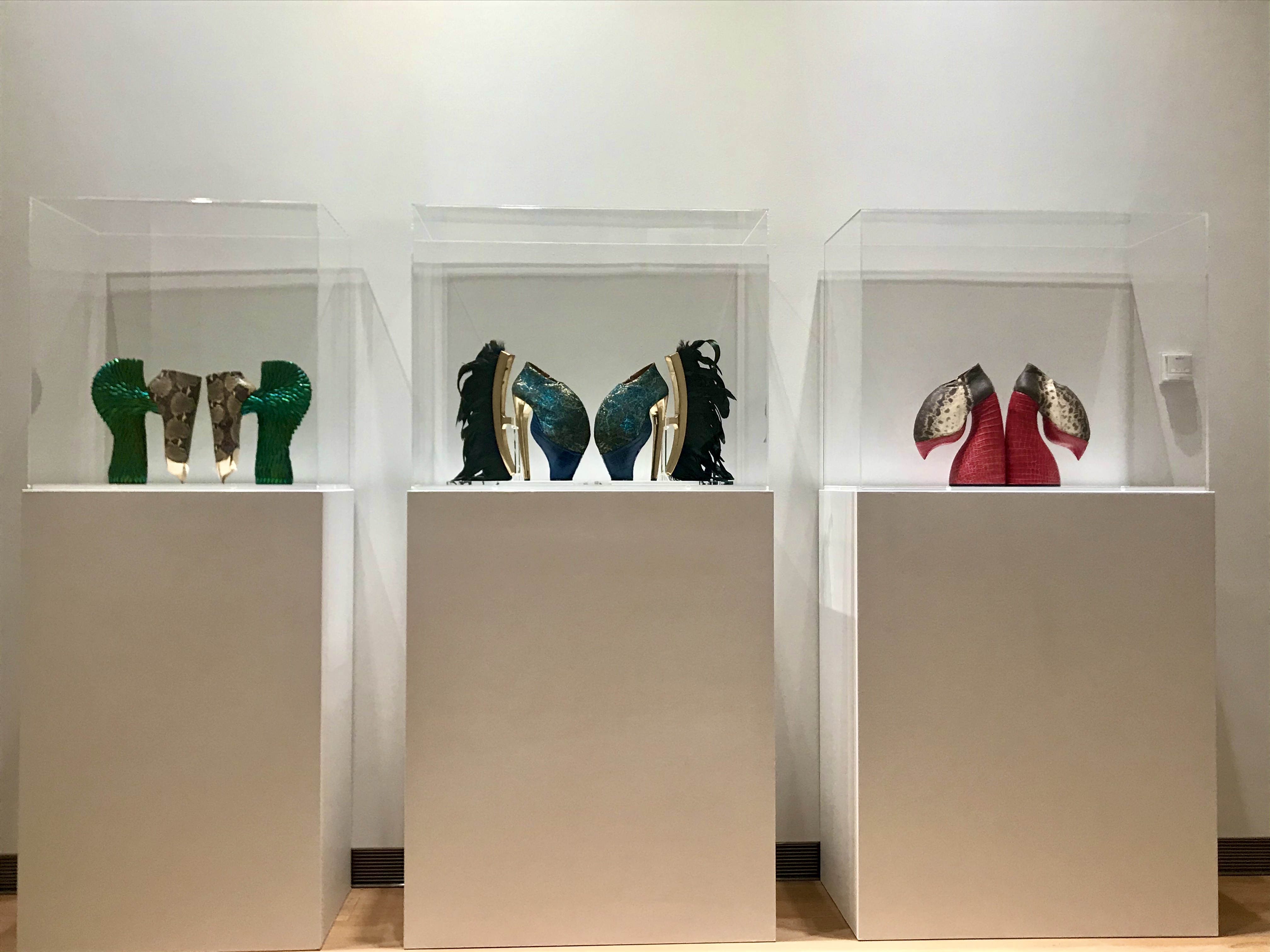Surrealism in Fashion: Expressions of Bizarre Imagination
Noritaka Tatehana, “Heel-less Shoes/Lady Pointe” (2004), Cowhide, pig suede, color, glass crystal, satin ribbon, private collection, photo by Gion
The 1920s–1960s was a revolutionary epoch in the arts, when Surrealism surfaced as a radical movement defying nationalism and Realism. It emphasized the power of personal imagination, tapping the unconscious mind and interests in myths, dreams, and fantasies. Surrealism influenced the fashion world immensely, generating new ideas about form, style, material, and concept. Fashion creators like Elsa Schiaparelli, John Galliano, Jan Fabre, and Martin Margiela injected Surreal notions of the bizarre and absurd into their designs. Their works included unconventionally shaped shoes garnished with stones and bird feathers, garments adorned with trompe-l’oeil illustrations, and grotesque art on jewelry, bags, gloves, and hats.
Tokyo Metropolitan Teien Museum is presenting Mode Surreal, A Crazy Love for Wearing until April 10th. This exhibition about Surrealism in fashion traces the movement through various modes, as seen in clothing and accessories as well as paintings, sculptures, and lithographs from the 16th century to the modern era.

In the first section, “Favoring the Organic,” the astounding Jacket from the 1930s is made of black ape hair by George Kines. Monkey fur, prevalent in the rainforests of Africa, was used to decorate clothing in the 1920s. Its popularity as a material for coats and jackets evolved into the 1930s. Meanwhile, tree and plant fibers have been woven into clothes throughout history. Belgian designer Jan Fabre is famous for creating garments made of jewel beetles and insect wings. His Hals Pantser (1996-2002) featured on the exhibition poster is a stupendous piece of artistic fashion that applies iron netting to jewel beetle wings.

A trend of weaving hair into garments that emerged in the 19th century has carried on into the present. High-end designer Martin Margiela displays his flowing Dress (2004) hemmed with brown-shaded hair and accented with a beaver fur necklace. The sensual Body Accessory (2004) by Japanese designer Yoichi Nagasawa is woven with braided artificial hair and truly catches the eye.

Centuries ago, European fashion was dictated by an almost obsessive desire for slender waists. The body had to be distorted forcibly to attain an idealized figure and the corset, typically worn by upper class women, became the fashionable solution for squeezing the torso. It was traditionally made of whalebone, then iron in the 16th century. Corset (1880s) is an elegant cobalt blue creation with gold threads and tassels.

Perhaps the epitome of 20th century Surreal fashion, Elsa Schiaparelli (1890-1973) embodied eccentric styles that incorporated nonconformist artistic themes like the human body, insects, and trompe-l’œil. Her famous collaborations with Salvador Dali, Jean Cocteau, Man Ray, and Alberto Giacometti were legendary, demonstrating her inventive imagination and fondness for tantalizing colors. After opening House of Schiaparelli in Paris in 1927, she met jeweler Jean Clément, who in 1936 presented her with fabric studies on the color pink. Schiaparelli was fascinated by the shade mixed with magenta and dubbed it “shocking pink,” later naming her ready-to-wear dress line after it. Even Yves Saint Laurent adopted this hue decades later. In 1937, Schiaparelli marketed blush, lipstick, and perfume (sold in a bottle shaped like the body of voluptuous actress Mae West) called Shocking. Salvador Dali also unveiled his sculpture Mae West Lips Sofa the same year. In the 1950s, the color was renamed “hot pink” and highlighted in Marilyn Monroe’s iconic dress in the hit film Gentlemen Prefer Blondes (1953). Schiaparelli‘s pink silk faille Evening Dress from 1952 (pictured) shows the upper chest curved like lips. Similarly, the silk crepe Evening Dress (1935) to the right is marked by match sticks while the silk velvet Evening Cape (1937) to the left is decorated with moire butterfly ribbons on the shoulders and chest. Printed fabrics were in vogue during the 1930s, but Schiaparelli preferred to insert provocative humor in a Surrealistic manner—a manifestation of the designer’s clever fusion of art and fashion.


Surrealism in jewelry was introduced by the likes of Max Ernst, Alexander Calder, and Jean Dubuffet, who created lively sculptural pieces like brooches and necklaces. Martin Margiela’s distinctive Necklace set (2006) is made from gold-plated wooden frames with hinges—an unusual choice of materials that categorizes the work as “abstract jewelry.” Dolce & Gabbana also displays items from its peculiar series Necklace (2005–2006). One piece features antique keys and the other colorful bottle caps made of plastic and brass.

Surrealistic shoe creations by Japanese designers Noritaka Tatehana and Masaya Kushino synthesize animal hide with insects and bird feathers, so that the wearer feels transformed into a hybrid creature. Tatehana is famous for his heel-less shoes, inspired by the tall geta of courtesans in the past. He has worked as pop diva Lady Gaga’s shoemaker for almost thirteen years. Kushino’s outlandish stilettos are made from python, crocodile, and cow skin attached with ostrich and crow feathers and the fur of lambs, foxes, and goats. Tatehana and Kushino's footwear narrows the boundaries between eclectic fashion and dreamlike art.

Non-fashion displays in the exhibition include paintings and sculptures by contemporary artists as well as 20th century titans like Salvador Dali, Man Ray, and Giorgio de Chirico. Ukiyo-e prints and vintage issues of Harper's Bazaar and Vogue are also among the displays.
Subscribers to the Tokyo Art Beat app are eligible for admission discounts to this exhibition.
Alma Reyes
Alma Reyes



